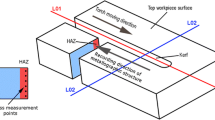Abstract
The finite differences method is used to calculate the temperature fields in an abrasive disk as a function of grinding conditions.
Similar content being viewed by others
Literature cited
P. I. Yashcheritsyn, A. K. Tsokur, and M. L. Eremenko, Thermal Phenomena in Grinding and the Properties of Ground Surfaces [in Russian], Minsk (1973).
V. I. Pilinskii, Finishing of Machine Parts [in Russian], Saratov (1983), pp. 7–11.
G. V. Bokuchava, Vestn. Mashinostr., No. 11, 11–13 (1963).
Yu. A. Mel'nikov and A. K. Tsokur, Inzh.-Fiz. Zh.,17, No. 5, 926–930 (1969).
K. A. Osipov, Problems of the Theory of the Heat Resistance of Metals and Alloys [in Russian], Moscow (1960).
L. N. Filimonov, High-Speed Grinding [in Russian], Leningrad (1979).
V. K. Saul'ev, Integration of Parabolic Equations by the Grid Method [in Russian], Moscow (1960).
Author information
Authors and Affiliations
Additional information
Translated from Inzhenerno-Fizicheskii Zhurnal, Vol. 56, No. 6, pp. 1008–1014, June, 1989.
Rights and permissions
About this article
Cite this article
Tsokur, A.K., Tsokur, A.Y. & Draevskii, A.I. Temperature fields in an abrasive tool. Journal of Engineering Physics 56, 713–718 (1989). https://doi.org/10.1007/BF00870447
Received:
Issue Date:
DOI: https://doi.org/10.1007/BF00870447




